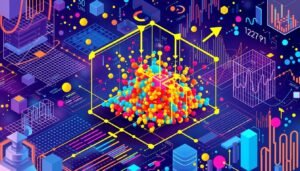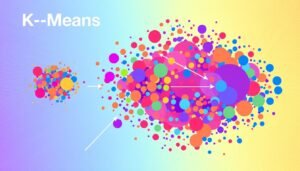AI in Data Analytics is transforming how organizations handle and understand data. With the massive volume of information businesses generate daily, AI plays a critical role in delivering deeper insights and supporting smarter decision-making.
Beyond simple number-crunching, AI uncovers hidden patterns, predicts future trends, and automates complex tasks. This innovation is revolutionizing industries like finance, healthcare, and marketing by making data more actionable and accessible.
In this article, we’ll explore how AI is impacting businesses of all sizes—and why it’s no longer just a trend, but a vital tool for thriving in today’s data-driven world.
Key Takeaways
- AI enhances data analytics by uncovering hidden patterns
- Businesses across industries benefit from AI-driven insights
- Artificial intelligence automates complex analytical tasks
- AI in data analytics improves decision-making processes
- The role of AI in modern data analytics is transforming business strategies
Understanding AI-Driven Data Analytics Fundamentals
AI-driven data analytics is changing how businesses get insights from big data. It mixes artificial intelligence with old data analysis methods. This helps find patterns and predict future trends.
Defining Modern Data Analytics
Modern data analytics with AI does more than just add numbers. It uses smart algorithms to understand complex data. This leads to deeper insights and better forecasts. Machine learning models get better over time, helping a lot.

Core Components of AI in Analytics
AI has a big impact on data analytics. It has several key parts that make it powerful:
- Machine Learning Algorithms
- Natural Language Processing
- Predictive Analytics
- Computer Vision
Evolution from Traditional to AI-Enhanced Analytics
The move from old to new analytics is huge. Here’s how they differ:
| Traditional Analytics | AI-Enhanced Analytics |
|---|---|
| Manual data processing | Automated data handling |
| Limited to structured data | Processes structured and unstructured data |
| Descriptive analysis | Predictive and prescriptive analysis |
| Static reporting | Real-time insights |
This change lets businesses make quicker, more precise choices. They do this with the help of detailed data analysis.
The Role of AI in Modern Data Analytics
AI tools for data analytics are changing how businesses get insights from big data. These tools make data processing faster, find hidden patterns, and predict outcomes accurately. AI automates tough tasks, letting humans focus on making big decisions.
Machine learning is key in making data analytics better. It helps systems learn from data, get better with new info, and improve models over time. This leads to more accurate and detailed insights.

- Faster data processing and analysis
- More accurate predictions and insights
- Automated pattern recognition
- Enhanced decision-making capabilities
- Improved operational efficiency
AI analytics tools can handle huge datasets quickly, giving businesses current insights. This is super useful in fast-moving industries where timely info is critical.
| Traditional Analytics | AI-Powered Analytics |
|---|---|
| Manual data cleaning | Automated data preparation |
| Limited data processing capacity | Scalable data handling |
| Static reporting | Real-time insights |
| Human-dependent analysis | Automated pattern recognition |
As AI gets better, its importance in data analytics will grow. Companies using these tools will have a big advantage in their markets.
How AI is Revolutionizing Data Processing and Analysis
AI is changing the game in data analytics, making it faster and more insightful for businesses. With big data and AI, companies can now handle huge amounts of info quicker and more accurately than ever.
Automated Data Cleaning and Preparation
One big challenge in data analysis is cleaning and getting data ready. AI tools now do this automatically, cutting down on mistakes and giving analysts more time. This lets businesses dive into insights instead of just managing data.
Pattern Recognition and Anomaly Detection
AI is great at finding patterns and oddities in big data sets. This skill is key for predictive analytics with AI, helping businesses predict trends and catch problems early. For instance, AI can find unusual transactions that might be fraud, helping protect company assets.
Real-Time Analytics Capabilities
AI’s strength in business intelligence is seen in real-time analytics. Now, companies can analyze data as it comes in, making quick decisions with the latest info. This is super useful in fast-moving industries where things change fast.
| Feature | Traditional Analytics | AI-Powered Analytics |
|---|---|---|
| Data Processing Speed | Hours to Days | Minutes to Seconds |
| Pattern Recognition | Limited to Predefined Rules | Advanced Machine Learning Algorithms |
| Real-Time Capabilities | Batch Processing | Continuous Analysis |
By using these AI features, businesses can get deeper insights, make smarter decisions, and stay on top in today’s competitive world.
Key Benefits of Implementing AI in Data Analytics
AI in data analytics changes the game for businesses. Companies using AI algorithms get insights faster and more accurately. This tech lets them make smarter choices and stay ahead.
One big plus of AI analytics is better decision making. AI quickly sorts through lots of data, helping leaders see trends and chances they might miss. This leads to smarter strategies and better results.
AI also makes things more efficient. Tasks that took days now take hours or minutes. This frees up teams to do more important work.
“AI-driven analytics has transformed our decision-making process, allowing us to respond to market changes with unprecedented speed and precision.”
Another big plus is AI’s predictive power. It looks at past data and current trends to predict the future. This helps businesses get ready for challenges and grab new opportunities.
| Benefit | Impact |
|---|---|
| Faster insights | Quicker response to market changes |
| Improved accuracy | Reduced errors in analysis and forecasting |
| Enhanced predictive power | Better preparedness for future scenarios |
| Increased efficiency | More time for strategic thinking and innovation |
By using these benefits, businesses can reach new heights of performance and innovation. AI in data analytics is more than a trend. It’s a key shift in how companies operate and compete today.
AI-Powered Predictive Analytics and Business Intelligence
AI is changing how we do predictive analytics and business intelligence. It uses ai in data mining and processing. This lets companies forecast trends and make decisions with great accuracy.
Forecasting and Trend Analysis
AI algorithms are great at finding patterns in big datasets. This skill helps businesses predict trends with high accuracy. For instance, retailers use AI to guess how much of a product to stock, cutting down on waste.
Decision Support Systems
AI-powered decision support systems give real-time insights for business strategies. They use ai in real-time analytics to analyze data from many sources. This gives executives quick, data-driven advice.
| Traditional Decision Making | AI-Powered Decision Making |
|---|---|
| Relies on historical data | Incorporates real-time data |
| Limited by human processing speed | Rapid analysis of vast datasets |
| Potential for bias | Objective analysis based on data |
Risk Assessment and Management
AI improves risk assessment by looking at many risk factors at once. In finance, AI predicts market changes and spots fraud. Insurance companies use AI to better understand policyholder risks, leading to fairer prices.
Adding ai in data visualization boosts these benefits. AI turns complex data into easy-to-understand visuals. This lets everyone quickly see important insights.
Machine Learning Applications in Modern Data Analysis
Machine learning is changing data analysis, adding new tools to ai in data science. It makes processes smoother and uncovers insights we didn’t see before. ML algorithms are changing how we work with and understand data.
In ai in data integration, machine learning is great at mixing different data sources. It finds patterns and links between various datasets. This creates a single view of information that was once split.
AI in data cleaning is another area where machine learning excels. ML algorithms can spot and fix errors, missing values, and inconsistencies in big datasets. This saves time and makes data better for analysis.
The importance of ai in data governance is growing. Machine learning helps follow data policies, check data quality, and meet regulations. It spots issues early, keeping data safe and reliable.
| Application | Benefits | Challenges |
|---|---|---|
| AI in Data Science | Faster insights, predictive capabilities | Need for skilled personnel |
| AI in Data Integration | Unified data view, improved data quality | Complex implementation |
| AI in Data Cleaning | Automated error detection, time savings | Potential for false positives |
| AI in Data Governance | Enhanced compliance, better data integrity | Privacy concerns |
As machine learning gets better, its use in data analysis will expand. Companies using these technologies will have an edge in their fields.
AI Tools and Technologies for Data Analytics
AI tools and technologies are changing data analytics. They bring new insights and help businesses grow. Let’s look at some key points about AI in data analytics.
Popular AI Analytics Platforms
Top AI platforms have strong features for data analysis. They are great at finding hidden patterns and making smart decisions. These tools are essential for businesses.
| Platform | Key Features | Best For |
|---|---|---|
| IBM Watson | Natural language processing, machine learning | Enterprise-level analytics |
| Google Cloud AI | Predictive modeling, deep learning | Large-scale data processing |
| Microsoft Azure AI | Cognitive services, AI-powered bots | Comprehensive AI solutions |
Integration Solutions
Seamless integration is key for AI in data analytics. Modern solutions link different data sources and tools. This makes insights easier to use and understand.
Custom AI Analytics Tools
Many companies create custom AI tools for their needs. These tools solve specific problems and boost data security. They offer unique benefits in data handling and analysis.
AI tools and technologies keep getting better. They provide new ways to get value from data. By using these solutions, businesses can stay ahead in today’s data-driven world.
Data Visualization and Storytelling with AI
AI is changing how we look at and share data. It helps us make complex data easy to understand. This is key because AI finds patterns and trends we might miss.
Now, AI tools make interactive visuals that change with what you input. This lets us dive deeper into data. AI does the hard work of making charts and graphs, so we can focus on what they mean.
AI has also changed how we tell stories with data. It can turn data into clear reports. This makes insights easy for everyone to understand, not just experts.
“AI-driven visualization tools are democratizing data analysis, allowing everyone from C-suite executives to front-line workers to gain valuable insights from complex datasets.”
As AI gets better, we’ll see new ways to show and share data. Imagine using augmented reality or AI to tell data stories. The future of data visualization is looking very exciting.
Challenges and Solutions in AI-Driven Analytics
AI tools for modern data analysis offer great benefits but also face challenges. Let’s look at the main hurdles and how to solve them in AI-driven analytics.
Data Quality and Governance
Poor data quality can cause wrong insights. AI needs clean, accurate data to work well. Companies must have strong data governance to keep data reliable. This includes regular audits, cleaning, and standardizing data formats.
Security and Privacy Concerns
As AI digs deeper into data, privacy risks grow. Firms must use strong security to protect sensitive info. Encryption, access controls, and anonymization are key. Successful companies balance data protection with innovation.
Implementation Hurdles
Adopting AI tools for data analysis can be tough. Many face skill gaps, resistance to change, and integration problems. To tackle these, companies should:
- Invest in employee training
- Start with small-scale AI projects
- Partner with AI experts for smooth implementation
Despite these challenges, AI in data analytics offers more benefits than drawbacks. Companies that tackle these issues can unlock powerful insights and stay ahead.
| Challenge | Solution | Impact |
|---|---|---|
| Data Quality | Data governance policies | Improved accuracy of insights |
| Security | Encryption and access controls | Enhanced data protection |
| Implementation | Training and partnerships | Successful AI adoption |
Future Trends in AI Analytics
The future of AI in data analytics is looking bright. New technologies are coming out fast. It’s clear AI will keep changing how businesses use data.
Emerging Technologies
Edge computing and 5G networks are changing AI analytics. They make processing faster and insights quicker. This will help AI analytics grow in many industries.
Industry Predictions
Experts say AI will soon be easier for small businesses to use. This will make things fairer, letting all companies use advanced analytics. The difference between AI and traditional data analytics will grow as AI gets better.
Innovation Roadmap
Businesses need a plan to use AI in data analytics. This includes:
- Investing in AI tools
- Training staff on new tech
- Improving data quality and governance
| Year | Predicted AI Analytics Advancements |
|---|---|
| 2024 | Widespread adoption of natural language processing in analytics |
| 2025 | Integration of AI with Internet of Things (IoT) for enhanced data collection |
| 2026 | Autonomous AI systems capable of self-improving analytics models |
As these trends come, the future of AI analytics looks bright. Companies that adapt will have a big edge in the data world.
Conclusion
AI is changing how businesses get insights and make choices. It helps find hidden patterns, predict trends, and automate tasks. This mix is leading to new ideas in many fields, like healthcare and finance.
The effect of AI on data analysis is huge. It makes data cleaning better, allows for quick analysis, and boosts prediction skills. With AI tools, companies can use lots of data to make smart decisions, staying ahead in the market.
The future of AI in data analysis looks promising. As tech gets better, we’ll see more advanced uses. Businesses that use these new tools will find new ways to grow and succeed.











